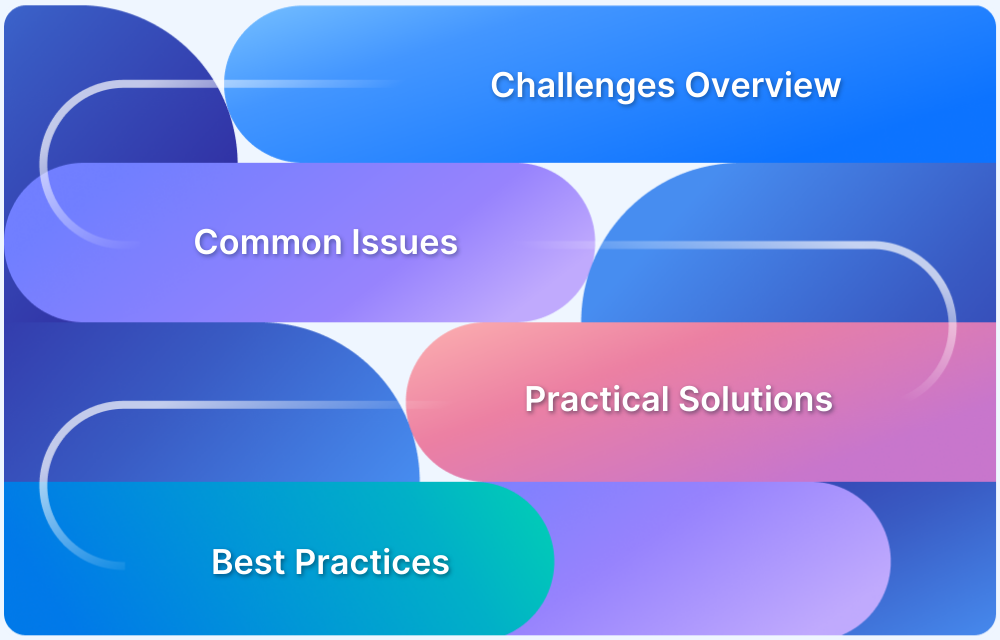With agile development becoming a cultural touchpoint for software development, nothing becomes more important to understand every aspect of its functioning. For software testers, understanding Agile testing means being future-ready and compatible with the constant innovations in the tech market.
As with anything too popular or frequently used, agile testing has run into a few myths which need to be debunked. This article aims to do just that so that one knows exactly what not to do or believe in when using this testing method to gain better results.
What is Agile Testing?
Agile Testing is based on the principles of agile development and involves the entire project team—testers, developers, and subject matter experts—collaborating throughout all stages of the Software Development Life Cycle (SDLC), including requirements gathering, design, coding, and test case creation.
Unlike traditional testing, which is often separate from development, Agile Testing is deeply integrated, enabling testers to provide continuous feedback and contribute to the process at every stage.
Read More: What is Agile Testing
Common Myths about Agile Testing
Agile development has transformed how software teams work together, streamlining collaboration and making product development more adaptive. However, Agile methodologies are often misunderstood—particularly when it comes to the role of software testers. Misconceptions about testing within Agile frameworks can lead to confusion about responsibilities, processes, and expectations, impacting a team’s ability to deliver quality software.
This article will clarify some of the most common myths surrounding Agile methods, especially those that relate to testing.
Myth 1: Agile Testing is done only when necessary
Every sprint in agile development begins with planning budget, resources, and testing. While the planning is not as rigid as that in the waterfall model, it always takes testing into account. In fact, test cycles are planned for every sprint in accordance with the user stories that developers intend to address in that sprint. Testing is central to the success of an agile development lifecycle and is executed religiously until the resulting product meets all requirements.
Myth 2: Agile Testing is all about the tools
The right testing tools certainly enable efficiency. For example, if a tester has to conduct cross browser compatibility testing to ensure that a website works with multiple browsers and browser versions (including older ones), it is best to use a platform designed for exactly that purpose. BrowserStack, for example, offers access to 2000+ real browsers and devices for live manual interactive cross browser testing and automated selenium testing. Instead of setting up and maintaining an in-house device lab, simply sign up, select device-browser-OS combinations and start testing.
Try Automated Selenium Testing for Free
However, it is important to note that what makes agile testing (and development) successful is its emphasis on collaboration among individuals and teams. Streamlining development and testing cycles for maximum efficiency is achieved primarily by a change in the mindset of the people involved. For example, test teams must be included in sprint meetings, so that they are involved from the very beginning i.e. user story identification. This enables better detection of issues right from the start so that development and testing can be planned accordingly.
Myth 3: Agile Testing is undocumented and haphazard
Agile processes consider documentation as important as any other aspect. But its point is not to have documentation for the sake of it. In agile, documentation exists on an ad-hoc basis.
Since swift communication facilitates collaboration, it would be counter-productive to abandon all documentation. Instead, agile encourages face-to-face communication as much as possible, so that the process moves faster. However, teams usually receive guidelines and requirements in the form of documentation. Additionally, a good agile team documents changes to code so that they can be aware of what works and what does not.
Myth 4: Developers can handle all the testing in agile teams. Dedicated testers are not needed.
In agile teams, developers and testers do not operate in watertight workspaces. Testing is built into every sprint and is often done by both developers and testers. But testers remain a very important part of the agile workflow. Consistent and iterative testing is the foundation of bug-free software.
The role of testers is more proactive in agile circles. Testers constantly collaborate with developers to ensure that every feature of a product is fully functional and aligned with all business and technical requirements. By identifying bugs early on in development, the code expands with minimal anomalies. This means testers have to find bugs, report and sometimes replicate them so that they can be eliminated before the end of each sprint.
A steady understanding of how testing works in agile development is the best way to implement it. Since testing goes hand-in-hand with every step of development in this method, testers must know exactly how to schedule and conduct tests in ways that yield the best results. Since organizations are increasingly going agile to get improved software quality and faster time to market at reduced costs, knowing how agile testing works makes a tester a much greater asset to their clients, employers, and teams.
Myth 5 – Agile doesn’t require planning
The idea that Agile skips planning is a misconception. Agile’s adaptive nature does not mean “no planning”; instead, it means “continuous planning.” Unlike traditional methods, which require rigid plans upfront, Agile allows for flexible, iterative planning that evolves as the project progresses.
Myth 6 – Agile only works for small projects
Some believe Agile is only suitable for small teams and projects. However, Agile has proven effective in large-scale projects by supporting scalable frameworks like SAFe (Scaled Agile Framework). Agile principles can be adapted to manage complex dependencies and large teams effectively, even at the enterprise level.
Myth 7 – Agile and Scrum are the same
Agile is an overarching philosophy with multiple methodologies, including Scrum, Kanban, and Lean. Confusing Agile with Scrum limits understanding of the diverse approaches available under the Agile umbrella, each tailored to different project needs and team dynamics.
Myth 8 – Agile is chaotic and unstructured
While Agile embraces flexibility, it is not disorderly. Agile follows structured frameworks like Scrum and Kanban, which bring order to iterations, sprints, and tasks. Agile’s adaptability allows teams to respond to changing requirements, but it still adheres to clear processes and goals.
Myth 9 – Agile guarantees perfection
Some see Agile as a guaranteed path to perfect software. However, Agile’s focus is on delivering functional software continuously, with room for improvement in each iteration. Agile embraces learning from mistakes and iterating rather than promising flawless results every time.
Myth 10 – Agile means no testing
Agile incorporates testing at every stage, with testers working alongside developers in sprints. Testing is part of Agile’s Shift Left approach, moving testing earlier in the process to catch issues quickly rather than leaving it as a final step.
Myth 11 – Agile sacrifices quality for speed
A frequent misconception is that Agile prioritizes speed at the cost of quality. Agile actually integrates testing throughout development, enabling rapid iterations without sacrificing quality. The continuous feedback loop helps teams improve quality at every step.
Myth 12 – Agile is easy to implement
Agile adoption may seem simple, but sustaining it requires commitment and cultural change. Agile involves a shift in mindset, demanding regular reflection, adaptation, and dedication to continuous improvement across the team and organization.
Myth 13 – Agile is only for software development
Agile principles can be applied to various fields beyond software development, including marketing, HR, and product management. The core idea of iterative processes, continuous feedback, and collaboration applies to a wide range of industries, not just tech.
Myth 14 – Agile teams work without clear roles
While Agile encourages collaboration and flexibility, it doesn’t mean there are no roles. Agile frameworks like Scrum clearly define roles such as Product Owner, Scrum Master, and Development Team. Each team member has a specific role to play, ensuring accountability and focus within the team.
Known Facts about Agile Testing
Some known facts include:
- Agile encourages documentation: Agile favors essential, clear documentation for effective communication and knowledge sharing, like user stories and acceptance criteria, rather than exhaustive specs.
- Agile requires proper planning: Agile involves iterative planning, allowing teams to adapt to changing needs with tools like the product backlog and sprint planning meetings.
- Agile suits various project sizes: Agile can scale, from small projects to large enterprises, using frameworks like SAFe, with success stories from companies like Spotify.
- Agile and Scrum differ: Agile is a broad philosophy, while Scrum is a specific framework. Other Agile frameworks like Kanban offer distinct workflows.
- Agile includes all roles: Agile is collaborative, involving testers, developers, and stakeholders. Practices like BDD ensure everyone contributes to quality.
- Agile is structured yet flexible: While adaptable, Agile frameworks (like Scrum) include defined roles, ceremonies, and artifacts, balancing structure with responsiveness.
- Agile doesn’t guarantee perfection: Agile views perfection as continuous improvement, with each sprint refining the product and process based on feedback.
- Testing is integral to Agile: Testing happens throughout Agile development, with early “shift-left” testing helping catch issues and maintain quality from the start.
- Agile prioritizes quality: Agile emphasizes quality, using methods like continuous integration and frequent testing to ensure production-ready increments.
- Agile is challenging to implement: Adopting Agile requires a cultural shift and commitment to learning, often demanding adjustments in roles and processes across the team.
Conclusion
In short, understanding Agile’s real principles — around planning, documentation, and flexibility — helps testers work effectively in fast-changing projects. Agile’s framework promotes teamwork and continuous improvement, making it possible to deliver quality software regularly.
For testers looking to succeed in Agile, BrowserStack Automate can be a big help. It lets teams test on real devices in the cloud, ensuring that software works smoothly across different platforms. With features like parallel testing, BrowserStack Automate makes it easier for Agile teams to run tests quickly and often, supporting faster releases without sacrificing quality.






